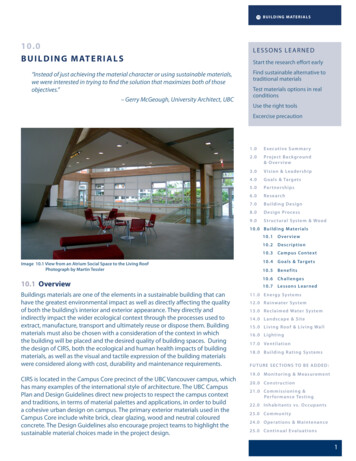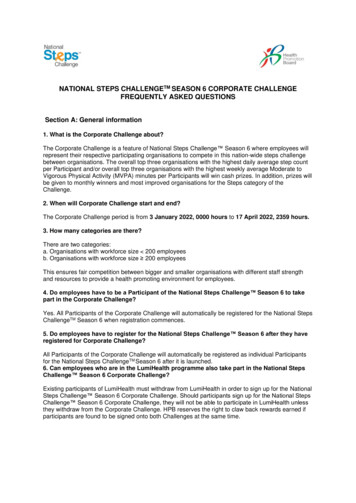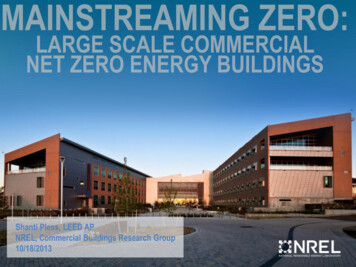
Transcription
THE LIVINGBUILDINGCHALLENGEJacques Chirazi, C.E.M, LEED GACertified Biomimicry ProfessionalMaster in BiomimicryEmail: jchirazi@gmail.com
AGENDA High Performance Building Leadership in Energy and Environmental Design Biophilic Design Zero Energy Building System Thinking Human Systems & Natural Resources Living Building Challenge LBC Group Exercise Case Studies Group Exercise - GoFish Game2
HIGH PERFORMANCE BUILDING
ENERGY POLICY ACT OF 2005 A "high performance building" means a building that integrates andoptimizes all major high-performance building attributes, includingenergy efficiency, durability, life-cycle performance, and occupantproductivity.4
LEADERSHIP IN ENERGY ANDENVIRONMENTAL DESIGN
LEADERSHIP IN ENERGY ANDENVIRONMENTAL DESIGN LEED (Leadership in Energy and Environmental Design) is anecology-oriented building certification program run by the U.S.Green Building Council (USGBC). LEED concentrates its efforts on improving performance acrossfive key areas of environmental and human health: energyefficiency, indoor environmental quality, materials selection,sustainable site development and water savings.6
WHY LEED? Lower operating costs and increase asset value Reduce waste sent to landfills – 50 – 90% costs savings Save energy – up to 30% Conserve water – 30 – 50% less water consumption Reduce harmful greenhouse gases – 35%7
SUSTAINABILITY PERSPECTIVE Buildings account for nearly half (48%) of all greenhouse gas emissions More than Transportation (27%) and More than Industry (25%) Buildings account for 76% of all electricity generated at power plants We spend over 90% of our time in a built environment.
WHY BUILDING GREEN?We can create better built environments and other environments in whichto work, play, live, and learn for generations to come.Sustainable development is formally defined by the World Commission onEnvironment and Development (WECD) as “development that meets theneeds of the people today without compromising the ability of futuregenerations to meet their own needs”.
GREEN ADVANTAGES Reduce human exposure to toxic materials Conserve natural resources Minimalize the ecological impact and materials Use renewal energy and materials Protect and restore ecosystems Positive influence on health and welfare of people
GREEN ADVANTAGES All this, and green buildingscan cost little or no more toconstruct than conventionalconstruction. Cost much less to maintainover their lifetime oftenproducing quick paybacks.
LEED CREDENTIALS
19
ENERGY INNOVATION CENTER In 2011, a building that began as a grocery store in the 1950s is now a place whereyou'll find the latest in energy and environmental technologies. The Energy Innovation Center is 1 of 10 buildings in the world to achievedouble LEED Platinum certification. Platinum is the highest rating in the LEED The center earned LEED Platinum for New Construction and Major Renovationin August 201270 Existing Buildings: Operation and Maintenance (EBOM) in December 2013.
URBANIZATION Today over half of the world’s population lives in urban areas, and thisnumber will increase to about two thirds of the world’s population by2050. That means that today, 3.9 billion people are living in cities, and thatnumber will continue to rise exponentially. Tokyo, Japan is today’s most populous city, with 38 million dwellers Jakarta, Indonesia with a population of of 32 million Delhi, India with a population of 25 million people and expected togrow to 36 million by 2030.21 In the U.S., 81% of our population of 320 million live in urban areas orsuburbs as of this year.
CITY FACTS22
23
BIOPHILIC DESIGN
BIOPHILIC DESIGN Biophilic design dates backto the early 1980s, when thebiologist Edward O. Wilsonoutlined his philosophy ofbiophilia, hypothesizing thathumans have an innate,biological affinity for thenatural world.25
BIOPHILIC DESIGN Biophilic design takes this idea one step further: Because humanstoday spend 90% of our time indoors. It’s necessary to bring the outdoors in and create indoorenvironments that reference nature in both obvious and subtle ways. A landmark 2019 study found that children in Denmark who hadbeen exposed to more greenery had 55% less mental healthproblems later in life compared to those who weren’t exposed tonature. Other research has shown that plants can reduce stress, help withfocus, and even increase immunity.26
BIOPHILIC DESIGN Scientists think that plants could act like sensors to help keep tabs onthings like mold and volatile organic compounds in our buildings. A 2016 report from the engineering firm Arup argues that buildingsshould all be covered with greenery as a way of pulling carbon dioxidefrom the air, filtering air pollution, reducing noise, and keeping citiescooler. To be happy and healthy and lead meaningful lives we need contactwith nature.27
THE BIOPHILIC CITIES By 2050, 70% of humanity will live in cities. But that doesn’t mean that city dwellershave to be disconnected from nature. The Biophilic Cities Project, an initiative organized by a Professor at the University ofVirginia’s School of Architecture. We have coevolved with the natural world and to be happy and healthy and leadmeaningful lives we need contact with nature. 28The percentage of population within a few hundred feet of a green spaceThe percentage of city land covered by vegetationNumber of green design features (i.e. rooftop gardens)Average portion of the day spent outside by residentsNumber of trips made on footPercent of residents who can identify local flora and faunaPriority given to nature conservation by local government
“In every walk with nature one receives far morethan one seeks.”- John Muir, 19 July 187729
30
31
32
BIOPHILIC DESIGN Biophilic design can reduce stress, improve cognitive function andcreativity, improve our well-being and expedite healing. As the world population continues to urbanize, these qualities are evermore important. Biophilia is the humankind’s innate biological connection with nature. It helps explain why crackling fires and crashing waves captivate us; whya garden view can enhance our creativity; and why animalcompanionship have restorative, healing effects. Biophilia may also help explain why some urban parks and buildings arepreferred over others.33
The human appreciation for thephysical beauty of the natural worldis often invoked as evidence ofbiophilia.For example, the appearance of thenatural world, with its rich diversityof shapes, colors, and life, isuniversally appreciated.
Reducing the average length of stay in hospitals by 0.41 days can amount to 93 million in reduced hospital costs every year.According to scientific studies, adequate access to daylighting and other biophilic elements can impact the health of patientsin such a positive way that they can achieve and possibly go beyond these estimated savings
“You never change things byfighting the existing reality.”“To change something, build anew model that makes theexisting model obsolete.”R. Buckminster Fuller37
SYSTEM THINKING
SYSTEM THINKING Ecological understanding requires shifting to anew way of thinking. One lesson that nature teaches is thateverything in the world is connected to otherthings. John Muir famously wrote, "When we try topick out anything by itself, we find it hitched toeverything else in the universe."39
40
LINEAR VS SYSTEM THINKING41
”The problems we have created in the world today will not besolved by the level of thinking that created them”Albert Einstein
HUMAN SYSTEMS & NATURALRESOURCES
46
KEY FACTS – ENERGY Renewable energy has an important role inproviding modern energy access to thebillions of people in developing countriesthat continue to depend on more traditionalsources of energy (e.g. biomass). More than 1.5 billion people worldwide still lackaccess to electricity. And more than 2.6 billion rely on wood, straw,charcoal, or dung for cooking. Renewable energy is a key factor in themodernization of billions of households andindustries.47Source: UNDP
NATURAL RESOURCES Worldwide demand for thesenatural resources (minerals,water etc ) were at a all timehigh in the 2007-08. In the 1900s the ‘World” hadabundant natural resources andvery a small human population. As of June 2019, the worldpopulation is 7.7 billion. The Earth’s “overshoot day” for2019 July 29, 2019 the point atwhich humanity goes intoecological debt, occurred onnine days earlier than last year. The Global Footprint Networkestimate that the world’spopulation currently consumesthe equivalent of 1.6 planets. 48This figure should rise to twoplanets by 2030 based on currenttrends
WATER CRISIS – 200849
HOW MANY EARTH DO WE NEED 50
NATURAL RESOURCES51
NATURAL RESOURCES52
WILDFIRES53
HIGHEST TEMPERATURE54
Your Course Title-Week 1HURRICANE IRMA55
GARBAGE IN THE OCEAN56
Your Course Title-Week 1PLASTIC FIBERS57
58
59
60
61The term “day zero” refers to the exact predicted date thatmunicipal authorities will cut off the taps to homes andbusinesses, meaning that a massive city — a city roughly thesize of Los Angeles — will have no access to running water.
62Instead, the government will be setting up about 200 water collection stations for residents togather their strictly-rationed 25 liters ( 6.6 gallons) per day. For context as to how much water thisactually is, the average American individual uses 300 liters (80 gallons) of water per day.Currently, Cape Town resident’s have already been advised to not consume more than about 85liters ( 22 gallons) per day.
CLIMATE POLICY
INTERNATIONAL PANEL ON CLIMATECHANGE (IPCC) The Intergovernmental Panel on Climate Change (IPCC) is a scientificintergovernmental body tasked with evaluating the risk of climatechange caused by human activity. A main activity of the IPCC is publishing reports on topics relevant tothe implementation of the UN Framework Convention on ClimateChange (UNFCCC) Implementation of the UNFCCC led eventually to the Kyoto Protocol. The aims of the IPCC are to assess scientific information relevant to: human-induced climate change, the impacts of human-induced climate change, options for adaptation andmitigation. The IPCC first assessment report was completed in 1990, and servedas the basis of the United Nations Framework Convention onClimate Change (UNFCCC).Source: IPCC64
THE KYOTO PROTOCOL The Kyoto Protocol is an international agreement linked to the UnitedNations Framework Convention on Climate Change. The major feature of the Kyoto Protocol is that it sets binding targets for 37industrialized countries and the European community for reducinggreenhouse gas (GHG) emissions. Annex I & Annex II countries These amount to an average of 5% against 1990 (base year) levels over thefive-year period 2008-2012. The Kyoto Protocol was adopted in Kyoto, Japan, on 11 December 1997 andentered into force on 16 February 2005. As of 2009 187 signed and ratified the treaty The treaty expired in 2012 Climate Change Conference Copenhagen Developing countries commitment to reduce GHGs emission Clean Power Plan sets to reduce carbon dioxide emissions by 32 percentfrom 2005 levels by 2030Source: IPCC65 Climate Change Conference, will be held in Paris, France from November 30to December 11, 2015
PARIS CLIMATE CHANGE AGREEMENT Holding the increase in the global average temperature towell below 2 C above pre-industrial levels To pursue efforts to limit the temperature increase to 1.5 C above preindustrial levels Ahead of the agreement, 186 countries submitted plansdetailing how they reduce their greenhouse gas pollutionthrough 2025 or 2030. The agreement requires all countries to submit updated plans thatwould ratchet up the stringency of emissions by 2020 and every fiveyears thereafter.66
PARIS CLIMATE CHANGE AGREEMENT The agreement acknowledges “the importance of averting,minimizing and addressing loss and damage associated withthe adverse effects of climate change.” This was deemed crucial by poor and small-island countries that sufferthe most from extreme weather and from long-term impacts likedroughts. The deal requires a global an overall assessment of howcountries are doing in cutting their emissions compared totheir national plans – starting in 2023, every five years.67
PARIS CLIMATE CHANGE AGREEMENT The deal requires countries to monitor, verify and report theirgreenhouse gas emissions using the same global system. The agreement a “Capacity-Building Initiative forTransparency” to help developing countries meet a newrequirement. The agreement, which takes effect in 2020: Calls on nations to establish “a new collective quantified goal” of atleast 100 billion a year in climate-related financing by 2020.68
69
ZERO ENERGY BUIDLING
ZERO-ENERGY BUILDING Zero-energy building (ZE)(zero net energy - ZNE)building, is a building withzero net energyconsumption: Meaning the total amountof energy used by thebuilding on an annual basisis equal to the amount ofrenewable energy createdon the site.71
ZNE Buildingshave very lowenergy loadssuch that theannual energyconsumptionis balanced byon-siterenewableenergy
1-3% added initial cost of construction couldsave up to 60 percent of energy use in newbuildings.California’s Net Zero Energy Building MandateTo Reshape US Construction IndustryBuildings are responsible for at least 40% ofenergy use in most countries. (The WorldBusiness Council for Sustainable Development)The first commercial-scalenet-zero building was acenter for environmentalstudies, completed atOberlin College in Ohio in2000. (Scientific America)
WHO IS GOING TO eJC Johnson Co.TNT ExpressBayerWalgreensIBEW 595PNC BankMorphosisMelink Corp.HinesKaiser Permanente Green Leaf InnTD BankDPR ConstructionHondaKB Homes3C CompanyHewlett PackardBubbly Dynamics Walt DisneyStates : CA, CO, DC, DE, MA, MN, NY, NM, OR, RI,VT, WACities: Seattle, Austin, Cambridge, Lancaster, FortCollins Tucson/Pima CountyAll U.S. Federal Buildings, The European UnionBritish Columbia, Canada
75
THE LIVING BUILDING CHALLENGE
LIVING BUILDING CHALLENGE The Living Building Challenge is an international sustainablebuilding certification program created in 2006 by the nonprofit International Living Future Institute. It is a certificationprogram that promotes the most advanced measurement ofsustainability in the built environment. It can be applied to development at all scales, from buildings both newconstruction and renovation to infrastructure, landscapes, neighborhoods and communities.77
THE LIVING BUILDING CHALLENGE International Living Future Institute The Living Building Challenge is theworld’s most rigorous provenperformance standard for buildings. The Living Building Challenge is a greenbuilding certification program andsustainable design framework thatvisualizes the ideal for the builtenvironment. It uses the metaphor of aflower because the ideal builtenvironment should function as cleanlyand efficiently as a flower.78
DESIGN FOR THE FUTURE With the Living Building Challenge, you can create buildings that are: Regenerative spaces that connect occupants to light, air, food, nature,and community. Self-sufficient and remain within the resource limits of their site. LivingBuildings produce more energy than they use and collect and treat allwater on site. Healthy and beautiful. Living buildings give more than they take, creating a positive impact onthe human and natural systems that interact with them.79
THE LIVING BUILDING CHALLENGE HASTWO CORE RULES All Imperatives assigned to aTypology are mandatory. Living Building Challengecertification requires actual,rather than anticipated,performance demonstrated overtwelve consecutive months.80
BULLITT CENTER The Bullitt Center was designed to showwhat’s possible today, changing the waypeople think about high performance greenbuilding. Unlike other green buildings, Living Buildingsmust prove themselves for a full year. They can’t contribute any waste to theenvironment. They can only use as muchwater as they can collect. And they must onlybe powered by as much energy as they cangenerate. In addition, all the heavy building materialslike concrete and steel must come fromwithin 300 miles of the site.71 And none of the building products can containany of the red-listed 362 toxic chemicals thatare commonly used in construction materials.
PETALS & IMPERATIVES The Living Building Challengeis organized into sevenperformance areas calledPetals. Each Petal is further subdivided into Imperatives,which address specific issuesthrough detailedrequirements.82
THE LIVING BUILDING CHALLENGE Seven performance areas, or ‘Petals’: Site, Water, Energy, Health, Materials, Equityand Beauty. Petals are subdivided into a total of twenty Imperatives, each of which focuses on aspecific sphere of influence. There are two rules: All Imperatives assigned to a Typology are mandatory. Some Typologies require fewer than twenty Imperatives because the conditions are eithernot applicable or may compromise other critical needs. However, teams are encouraged to integrate the optional Imperatives into their projectswherever possible. Living Building Challenge certification is based on actual, rather than modeled oranticipated, performance.83 Therefore, projects must be operational for at least twelve consecutive months prior toevaluation.
84
85
GROUP ACTIVITY
BIOMIMICRY
WHAT IS BIOMIMICRY? Biomimicry is the practice of applying lessons from nature to theinvention of healthier, more sustainable technologies for people. Biomimetic designers (“biomimics”) focus on understanding, learningfrom, and emulating the strategies used by living things, with theintention of creating designs and technologies that are sustainable. “Conscious”: being intentional “Emulation”: learning from living things, then applying those insights to thechallenges humans want to solve. “Life’s genius”: recognizing that life has arrived at well-adapted solutions thathave stood the test of time, within the constraints of a planet with finiteresources.
Man-made designsNature’s designsLinear systemCyclical systemHomogeny & UniformityDiversityMaximization of resourcesOptimization of resourcesHeat, beat & treatSelf assemblyCheapest sourcesLocally sourcedDisposableBiodegradable
FUNCTION AND STRATEGY
formprocesssystem
INTEGRATE BIOLOGY INTO DESIGN The biological mechanism of what is happening must beunderstood. Think of mechanism as how the strategy works. Strategy is how the function is achieved. The function is what nature is doing.
How do Polar Bears keep themselves warm?
Function: Attachment on wetsurfaceStrategy: Regular microstructureon toe pads increasesattachment forcesDesign Principle: A microstructure offractal hexagons withcapillary size channelprovides attachmentto wet surface
GROUP ACTIVITY
“Each species is a masterpiece ”E.O. WilsonJacques ChiraziBiomimicry San DiegoCertified Biomimicry Professional Founderjchirazi@gmail.com
LEED (Leadership in Energy and Environmental Design) is an ecology-oriented building certification program run by the U.S. Green Building Council (USGBC). LEED concentrates its efforts on improving performance across five key areas of environmental and human health: energy efficiency, indoor environmental quality, materials selection,











